PANASONIC Toughbook CF-29 User Manual

1
Personal Computer
Reference Manual
Model No. CF-29 Series
XP
We recommend that this Reference Manual be printed.

Read Me First
2
zSome of the illustrations in this manual may differ slightly in shape from the actual items in order to make the explanation easier to understand.
zIf the user has logged on without the administrator authority, some functions may not be executable, and some screens may be not displayed as shown in this manual.
If this happens, log on with the administrator authority to enable these functions.
zThis manual covers two types of models, as distinguished by the type of LCD screen models with touchscreen and models without touchscreen).
zConfirm the latest information on optional products in catalogs, etc.
zThe following drives may be described as "CD/DVD drive".
CD-ROM drive, DVD-ROM drive, CD-R/RW drive, DVD-ROM & CD-R/RW drive, DVD MULTI drive
Illustrations and Terminology in this Reference Manual
|
NOTE |
NOTE provides a useful fact or helpful information. |
|||||
|
CAUTION |
CAUTION indicates a condition that may result in |
|||||
|
|
|
|
|
|
|
minor or moderate injury. |
|
|
Enter |
|
|
This illustration means to press the [Enter] key. |
||
|
Fn |
+ |
F5 |
|
This illustration means to press and hold the [Fn] key, |
||
|
|
|
|
|
|
|
then press the [F5] key. |
|
[start] - [Run] |
This illustration means to click [start], then to click |
|||||
|
|
|
|
|
|
|
[Run]. For some applications, you may need to double- |
|
|
|
|
|
|
|
click. |
|
Î or |
These symbols indicated related pages. |
|||||
|
|
|
|
|
|
|
Î : Refer to the page in this Reference Manual |
|
|
|
|
|
|
|
: Refer to the Operating Instructions |
|
Orange*1 |
If *1 is selected, it will jump to a related explanatory |
|||||
|
|
|
|
|
|
|
note. |
|
|
|
|
|
|
|
|

Read Me First
|
|
3 |
|
|
|
About Display Mode |
|
|
|
|
|
|
Internal LCD (Notebook) |
This computer's display |
|
External Display (Monitor) |
External display connected to this computer |
|
Simultaneous display (Intel(R) Dual Display |
To display the same screen on both the LCD |
|
Clone) |
and external display |
|
Extended Desktop |
To use both the internal LCD and the |
|
|
external display as an extended display |
|
|
domain. You can drag a window from the |
|
|
internal LCD to the external display. |
|
|
|
The terminology in ( ) is the one used in [Intel(R) 82852/82855 GM/GME Graphics Controller properties].
To display [Intel(R) 82852/82855 GM/GME Graphics Controller properties]:
Select [start] - [Control Panel] - [Other Control Panel Options] - [Intel(R) Extreme Graphics 2 M].
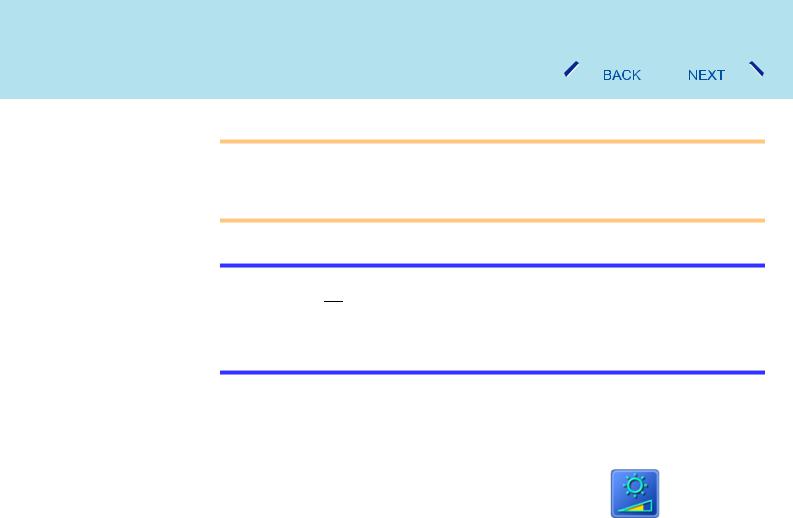
Key Combinations
4
CAUTION
Do not press the following key combinations repeatedly in (quick) succession. Also, do not press different key combinations quickly one after another.
Do not press the following key combinations while using the touch pad (external mouse), touchscreen (only for models with touchscreen) or other keys.
NOTE
Do not press the following key combinations until you log on to Windows and the hard disk drive indicator turns off. Note, however, that the key combinations Fn+F1, Fn+F2 and Fn+F3 are operable in the Setup Utility.
The key combinations below may not work while some applications are running. Besides, the popup window may not be displayed depending on the state of the application you are using (e.g., when [Command Prompt] is set to "Full Screen").
|
|
Key |
|
Functions |
Popup Window |
||
|
|
|
|
|
|
|
(Displayed after logging |
|
|
|
|
|
|
|
on to Windows) |
|
|
+ |
|
|
|
LCD brightness control (down) |
|
Fn |
F1 |
|
|||||
|
|
|
|
|
|
LCD brightness control (up) |
|
|
Fn |
+ |
F2 |
|
Pressing this key combination adjusts the |
|
|
|
|
|
|
|
|
brightness of LCD. |
|
|
|
|
|
|
|
The brightness setting is stored in memory |
|
|
|
|
|
|
|
separately under the condition the AC adaptor is |
|
|
|
|
|
|
|
connected and under the condition the AC adaptor |
|
|
|
|
|
|
|
is not connected. |
|
|
|
|
|
|
|
|
|

Key Combinations
|
|
|
|
|
|
|
|
5 |
|||
|
|
|
|
|
|
|
|
|
|
||
|
|
Key |
|
|
Functions |
|
|
|
Popup Window |
||
|
|
|
|
|
|
|
|
|
|
(Displayed after logging |
|
|
|
|
|
|
|
|
|
|
|
|
on to Windows) |
|
|
+ |
|
|
|
|
Display change |
|
|
|
|
Fn |
F3 |
|
|
|
|
||||||
|
|
|
|
|
|
|
By pressing this key combination, you can select |
|
|
|
|
|
|
|
|
|
|
|
either an external display, internal LCD or |
|
|
|
|
|
|
|
|
|
|
|
simultaneous. ( page 63) |
|
|
|
|
|
|
|
|
|
|
|
This key combination does not work when |
|
|
|
|
|
|
|
|
|
|
|
[Command Prompt] is set to "Full Screen". |
|
|
|
|
|
|
|
|
|
|
|
CAUTION |
|
|
|
|
|
|
|
|
|
|
|
|
|
|
|
|
|
|
|
|
|
|
|
Do not press another key until the display |
|
|
|
|
|
|
|
|
|
|
|
destination has been completely switched. |
|
|
|
|
|
|
|
|
|
|
|
Do not press this key combination in the |
|
|
|
|
|
|
|
|
|
|
|
following conditions. |
|
|
|
|
|
|
|
|
|
|
|
• While MPEG files are playing. |
|
|
|
|
|
|
|
|
|
|
|
• When the Extended Desktop is being |
|
|
|
|
|
|
|
|
|
|
|
utilized. |
|
|
|
|
|
|
|
|
|
|
|
|
|
|
|
|
|
|
|
|
|
|
|
NOTE |
|
|
|
|
|
|
|
|
|
|
|
|
|
|
|
|
|
|
|
|
|
|
|
When switching to a different user with the |
|
|
|
|
|
|
|
|
|
|
|
Fast User Switching function, this key |
|
|
|
|
|
|
|
|
|
|
|
operation may not work. In this case, log off |
|
|
|
|
|
|
|
|
|
|
|
all users and restart the computer. |
|
|
|
|
|
|
|
|
|
|
|
|
|
|||
|
|
|
|
|
|
|
|
|
|
|
|
|
|
+ |
|
|
|
|
Speaker on/off switch |
|
|
|
|
Fn |
F4 |
|
|
|
|
|
|
||||
|
|
|
|
|
|
|
Pressing this key combination turns on/off audio |
|
|
|
OFF |
|
|
|
|
|
|
|
from the internal speaker and headphone jack. |
|
|
|
(MUTE) |
|
|
|
|
|
|
|
NOTE |
|
|
|
ON |
|
|
|
|
|
|
|
|
|
|
|
|
|
|
|
|
|
|
|
Disabling the speakers will also disable the |
|
|
|
|
|
|
|
|
|
|
|
warning beep. |
|
|
|
|
|
|
|
|
|
|
|
Speakers connected to the USB port |
|
|
|
|
|
|
|
|
|
|
|
cannot be muted. |
|
|
|
|
|
|
|
|
|
|
|
|
|
|
|
|
|
|
|
|
|
|
|
|
|
|
|
|
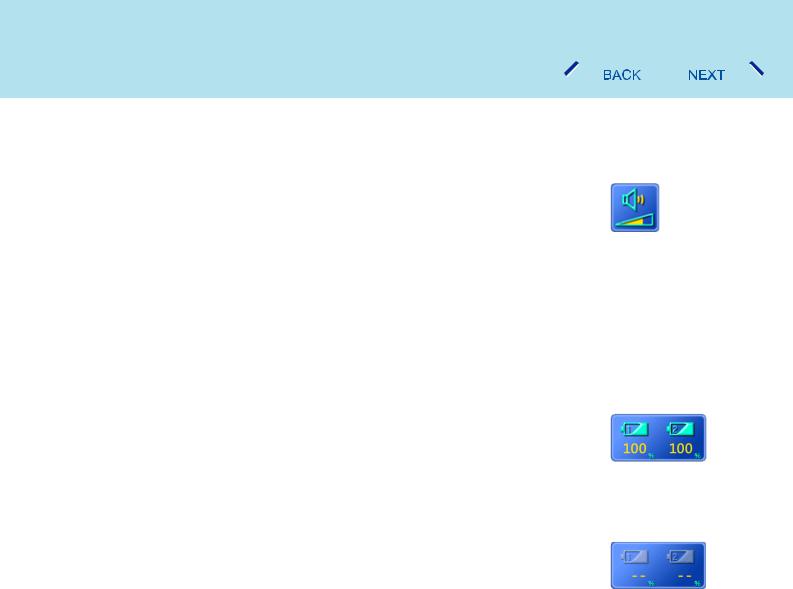
Key Combinations
|
|
|
|
|
|
|
|
|
|
6 |
||||
|
|
|
|
|
|
|
|
|
|
|||||
|
|
Key |
|
Functions |
|
|
|
|
Popup Window |
|||||
|
|
|
|
|
|
|
|
|
|
|
|
|
(Displayed after logging |
|
|
|
|
|
|
|
|
|
|
|
|
|
|
|
on to Windows) |
|
|
+ |
|
|
|
|
|
|
Volume control (down) |
|
|
|
|
|
Fn |
F5 |
|
|
|
|
|
||||||||
|
|
|
|
|
|
|
|
|
Volume control (up) |
|
|
|
|
|
|
Fn |
+ |
F6 |
|
|
|
Pressing this key combination adjusts the volume |
|
||||||
|
|
|
|
|
|
|
|
|
of the internal speaker and headphone jack. |
|
||||
|
|
|
|
|
|
|
|
|
NOTE |
|
|
|
|
|
|
|
|
|
|
|
|
|
|
|
|
|
|
|
|
|
|
|
|
|
|
|
|
|
This key combination cannot be used to |
|
||||
|
|
|
|
|
|
|
|
|
adjust the volume of the warning beep or |
|
||||
|
|
|
|
|
|
|
|
|
speakers connected to the USB port. |
|
||||
|
|
|
|
|
|
|
|
|
||||||
|
|
|
|
|
|
|
|
|
||||||
|
|
+ |
|
|
|
|
Power off using the standby function |
|
|
|
||||
Fn |
F7 |
|||||||||||||
|
|
|
|
|
|
|
|
|
Pressing this key combination causes the current |
|
||||
|
|
|
|
|
|
|
|
|
status of the computer to be saved to memory, and |
|
||||
|
|
|
|
|
|
|
|
|
powers off the computer. ( page 26) |
|
||||
|
|
|
|
|
|
|
|
|
||||||
|
|
+ |
|
|
|
|
|
|
Remaining capacity of the battery pack |
|
||||
Fn |
F9 |
|||||||||||||
|
|
|
|
|
|
|
|
|
Pressing this key combination displays the |
|
||||
|
|
|
|
|
|
|
|
|
remaining battery capacity on the screen. |
|
||||
|
|
|
|
|
|
|
|
|
|
|
|
When the battery pack is |
||
|
|
|
|
|
|
|
|
|
|
|
|
inserted in the computer |
||
|
|
|
|
|
|
|
|
|
|
|
|
(example) |
||
|
|
|
|
|
|
|
|
|
|
|
|
When the battery pack is |
||
|
|
|
|
|
|
|
|
|
|
|
|
not inserted in the |
||
|
|
|
|
|
|
|
|
|
|
|
|
computer |
||
|
|
|
|
|
|
|
|
|||||||
|
|
+ |
|
|
|
|
|
|
Power off using the hibernation function |
|
|
|
||
Fn |
F10 |
|||||||||||||
|
|
|
|
|
|
|
|
|
Pressing this key combination causes the current |
|
||||
|
|
|
|
|
|
|
|
|
status of the computer to be saved to the hard disk, |
|
||||
|
|
|
|
|
|
|
|
|
and powers off the computer. ( |
page 26) |
|
|||
|
|
|
|
|
|
|
|
|
|
|
|
|
|
|

Key Combinations
7
Hotkey Settings
There are two Fn key functions as follows: Fn key lock function
After Fn is pressed once, it stays in the "pressed" position until another key is pressed. This is convenient when it is difficult to press two buttons simultaneously.
Popup windows display ON/OFF
1 Run the Hotkey Settings.
Select [start] - [All Programs] - [Panasonic] - [Hotkey Settings].
2 Set the parameters.
A. Use Fn key lock
Add the check mark if you want to enable the Fn key lock function. The following Fn key lock function will then be enabled.
To use Fn only once:
APress Fn once. (Locked)
BPress another key for combination. (Lock released) To use Fn successively:
APress Fn twice. (Locked)
BPress another key for combination.
Fn key remains locked until Fn is pressed once more.
B.Notification
This setting is only available when [Use Fn key lock] is checked.
[Make sounds when Fn key is pressed]*1
Notifies the user with a sound when Fn is locked or released.
[Show status on screen]:
Displays the Fn key status on the taskbar.
 :Fn is locked
:Fn is locked
 :Fn is not locked
:Fn is not locked
C.Disable popup
Add the check mark if you want to turn the popup window display function OFF. The full-screen display of [Command Prompt] screen or MPEG files may change to a window display if Fn+Fx*2 keys are pressed. To prevent this, turn the popup window display function OFF.

Key Combinations
8
3 Select [OK].
NOTE
The Fn key lock function also works with Fn and other keys (e.g. , ) aside from
Fx*2.
Each user can select separate settings for whether or not to use the Hotkey settings.
*1 |
If MUTE is set, you will not hear a beep. |
||||||
*2 |
" |
|
" indicates any function key from |
|
to |
|
. |
Fx |
F1 |
F10 |
|||||
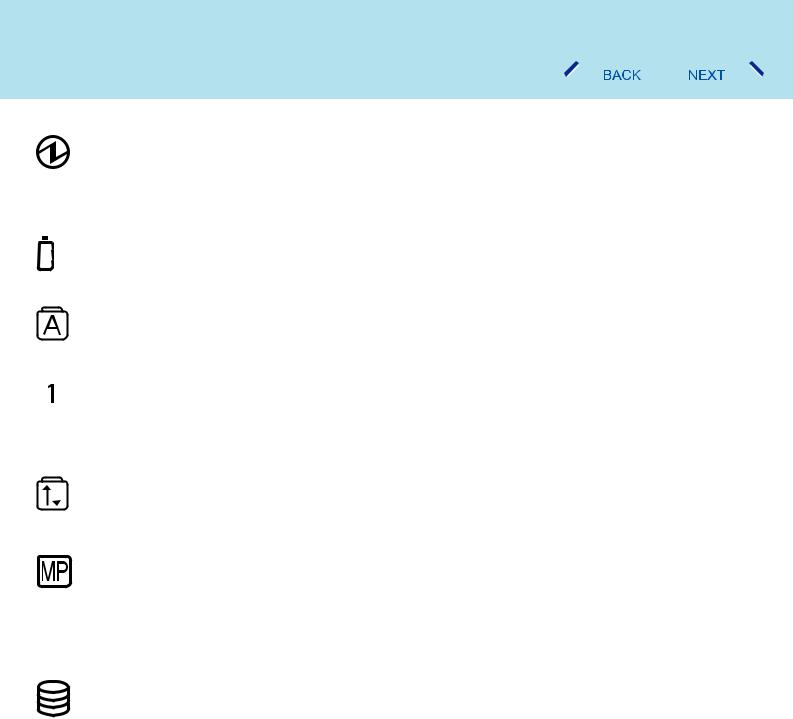
LED Indicators
|
|
|
|
|
9 |
|||||
|
|
|
|
|
|
|||||
|
|
|
|
Power status |
Not lit |
|||||
|
|
|
|
|
Power off / Hibernation mode |
|||||
|
|
|
|
|
Green |
|||||
|
|
|
|
|
Power on |
|||||
|
|
|
|
|
Blinking green |
|||||
|
|
|
|
|
Standby mode |
|||||
|
|
|
|
|
|
|||||
|
|
|
|
Battery pack status |
page 41 |
|||||
|
|
|
|
|
|
|
|
|
|
|
|
|
|
|
Caps Lock |
This indicator lights green when |
|
|
|
is pressed. Subsequent non- |
|
|
|
|
|
CapsLock |
||||||
|
|
|
|
|
shifted input is capitalized. |
|||||
|
|
|
|
|
|
|
|
|
||
|
|
|
|
NumLk |
This indicator lights green when |
|
|
|
is pressed. This causes a portion |
|
|
|
|
|
NumLk |
||||||
|
|
|
|
(Numeric key) |
of the keyboard to function as a numeric keypad. The [Enter] key functions |
|||||
|
|
|
|
|||||||
|
|
|
|
|
differently depending on the application. |
|||||
|
|
|
|
|
(If an external keyboard or ten-keyboard is connected to the external |
|||||
|
|
|
|
|
||||||
|
|
|
|
|
keyboard/mouse port, the numeric keypad of the internal keyboard will not |
|||||
|
|
|
|
|
operate.) |
|||||
|
|
|
|
|
|
|
|
|||
|
|
|
|
ScrLk |
This indicator lights green when |
|
is pressed. Scroll lock functions |
|||
|
|
|
|
ScrLk |
||||||
|
|
|
|
(Scroll lock) |
differently depending on the application. |
|||||
|
|
|
|
|
|
|
|
|
|
|
|
|
|
|
|
|
|
|
|
|
|
|
|
|
|
Multimedia pocket device |
This indicator lights when the multimedia pocket device ( page 49) is |
|||||
*1 |
status |
accessed. |
||||||||
|
|
|
|
|
(When using the floppy disk drive as an external floppy disk drive, only |
|||||
|
|
|
|
|
the access lamp on the side of the floppy disk drive is lit.) |
|||||
|
|
|
|
|
This indicator shows the status of a second battery pack when a second |
|||||
|
|
|
|
|
battery pack is installed in the multimedia pocket. The details of the |
|||||
|
|
|
|
|
status display are the same as for the main battery pack status ( page |
|||||
|
|
|
|
|
41). |
|
|
|
|
|
|
|
|
|
|
|
|||||
|
|
|
|
Hard disk drive status |
This indicator lights when the hard disk drive is accessed. |
|||||
|
|
|
|
|
|
|
|
|
|
|

LED Indicators
|
|
10 |
|
|
|
|
Power status of the |
This indicator lights when power is supplied to a device in the multimedia |
*1 |
multimedia pocket |
pocket. |
|
|
It is not lit when a second battery pack is installed in the multimedia |
|
|
pocket. |
|
|
You can confirm the status of the second battery pack with |
|
|
(multimedia pocket device status). |
|
|
|
*1 MP is the abbreviation for Multimedia Pocket.
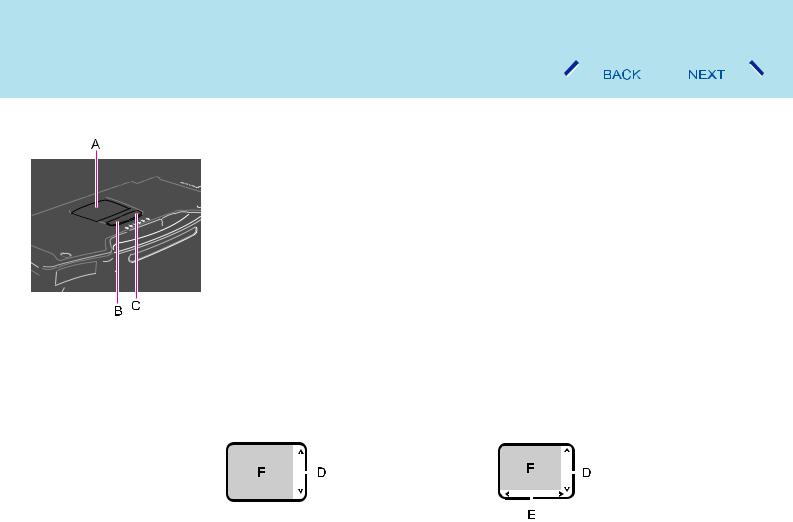
Touch Pad
11
Use the touch pad to move the cursor on the display and perform normal computer operations.
A. Work Surface (Touch Pad) B. Left Button
C. Right Button
The touch pad has the following two modes of operation.
Microsoft® IntelliMouse™ Wheel Mode |
|
|
|
|
|
|
Original Mode |
||||
(Setting at the time of purchase) |
|
|
|
|
|
|
|
||||
Wheel mode operations (almost identical to |
Only scroll operation is possible for |
||||||||||
the case of using the Microsoft® |
applications not compatible with the |
||||||||||
IntelliMouse™ for scroll, zoom, etc., |
Microsoft® wheel function. |
||||||||||
operations) are possible for Microsoft® |
Even for applications compatible with the |
||||||||||
wheel function-compatible applications. |
Microsoft® wheel function, there are cases |
||||||||||
|
|
|
|
|
where only vertical scrolling or only |
||||||
Microsoft® IntelliMouse™ is a mouse-type |
horizontal scrolling is possible in this mode. |
||||||||||
device that, in addition to the two |
|
|
|
|
|
|
|
||||
conventional buttons, incorporates a wheel |
|
|
|
|
|
|
|
||||
able to rotate forwards/backwards. |
|
|
|
|
|
|
|
||||
|
|
|
|
|
|
|
|
|
|
|
|
|
|
|
|
Scrolling Area |
|
|
|
|
|
|
Scrolling Area |
|
|
|
|
|
|
|
|||||
|
|
|
|
D.Scrolling up/down |
|
|
|
|
|
|
D.Scrolling up/down |
|
|
|
|
For the Pan and Auto |
|
|
|
|
|
|
Possible when a check |
|
|
|
|
Scroll functions, the |
|
|
|
|
|
|
mark is added for |
|
|
|
|
|
|
|
|
||||
|
|
|
|
|
|
|
|
|
|
||
|
|
|
|
entire work surface of |
|
|
|
|
|
|
[Vertical]. |
|
|
|
|
the touch pad can be |
|
|
|
|
|
|
E.Scrolling side-to- |
|
|
|
|
used for scrolling. |
|
|
|
|
|
|
side |
|
|
|
|
|
|
|
|
|
|
|
Possible when a check |
|
|
|
|
|
|
|
|
|
|
|
mark is added for |
|
|
|
|
|
|
|
|
|
|
|
[Horizontal]. |
|
|
|
|
|
|
|
|
|
|
|
|
Typical mouse operations use the area (F): When no check mark is added for [IntelliMouse Wheel mode], [Horizontal] and [Vertical] of [Scroll Configuration], the entire surface can be used for typical mouse operations.(Î page 12)
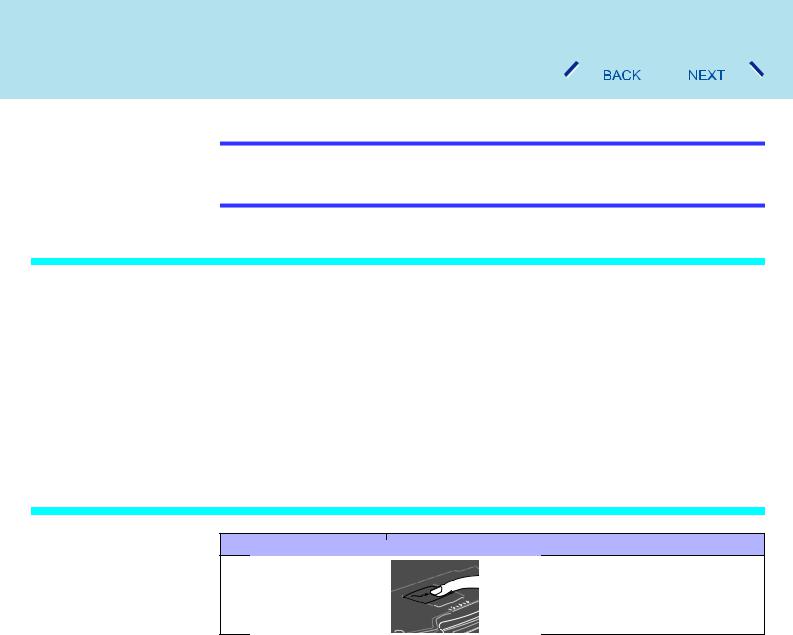
Touch Pad
12
NOTE
zWhen you are not sure whether an application is compatible with the Microsoft® wheel function or not, try using both modes. Furthermore, depending on the application, there are cases where scrolling may not be possible with either mode.
Changing the Mode of the Touch Pad
ADisplay the setting menu.
Select  (models with touchscreen) or
(models with touchscreen) or  (models without touchscreen) on the taskbar or select [Mouse] in [start] - [Control Panel] - [Printers and Other Hardware] - [Mouse], and then select [TouchPad].
(models without touchscreen) on the taskbar or select [Mouse] in [start] - [Control Panel] - [Printers and Other Hardware] - [Mouse], and then select [TouchPad].
BChange the settings.
z To set the Microsoft® IntelliMouse™ Wheel mode
Add the check mark for [IntelliMouse Wheel mode] of [Scroll Configuration]. z To set the original mode
Remove the check mark for [IntelliMouse Wheel mode] of [Scroll Configuration] and then add the check mark for [Vertical] and/or [Horizontal].
CSelect [OK].
Operating the Touch Pad
Function |
Operation |
Moving the Cursor
Move the tip of your finger lightly over the work surface.
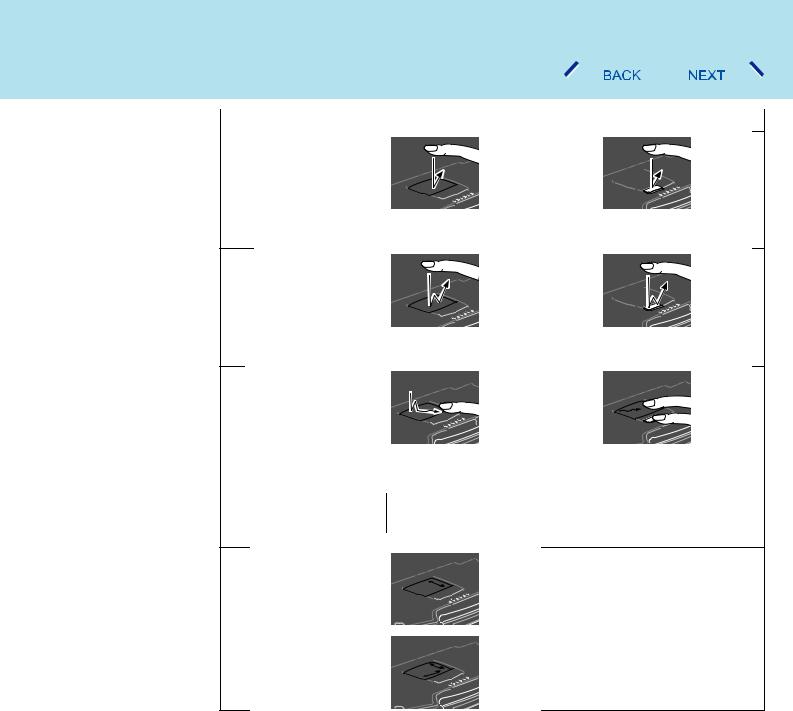
Touch Pad
13
Function |
|
Operation |
|
|
|
Tapping/Clicking
tapping |
or |
clicking |
Double-Tapping/Double-
Clicking
double-tapping |
or |
double-clicking |
Dragging
Two quick taps, but on the second tap leaving your finger down (applying pressure) and moving it on the work surface. or
While holding down the button, moving your finger on the work surface.
Scroll *1 |
Microsoft® IntelliMouse™ Wheel Mode |
Scroll a document. |
|
(rotate the wheel)*2 |
|
|
Original Mode |
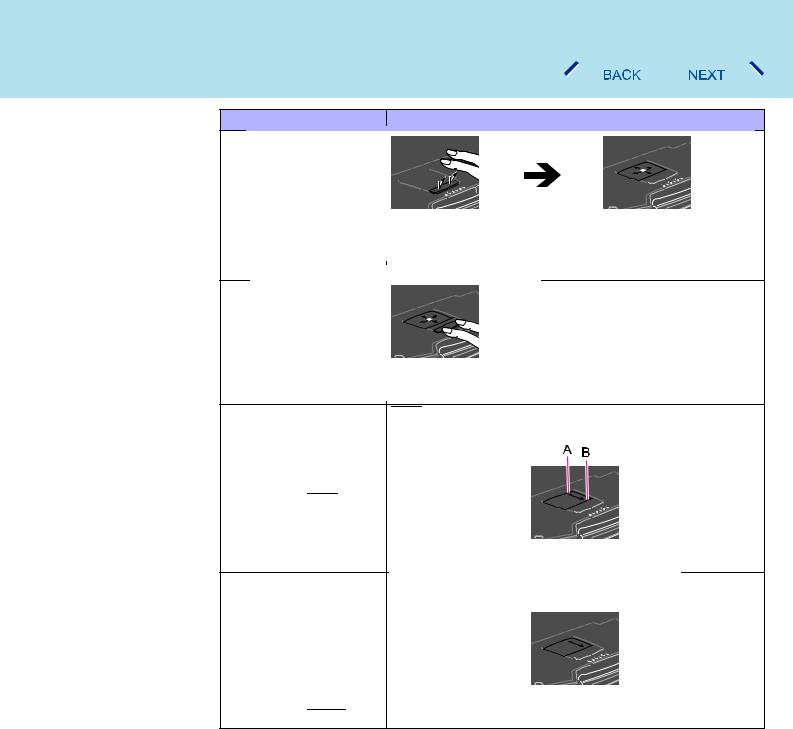
Touch Pad
14
Function |
Operation |
Auto Scroll*1*3
Automatically scroll a |
|
document. |
|
(move the mouse after |
|
clicking the wheel)*2 |
Operate after pressing the two buttons simultaneously. |
|
|
|
z When releasing the auto scroll function: One tap on the |
|
work surface. |
Pan*1*3 |
Operate while holding down the two buttons. |
|
|
Scroll in various directions |
|
of a document. |
|
(move the mouse slightly |
|
while holding down the |
|
wheel)*2 |
|
Zoom*1*3 |
Ctrl+ |
Magnify/reduce the |
|
display of a document. |
|
(rotate the wheel while |
|
holding down Ctrl)*2 |
|
|
A. Magnify |
|
B. Reduce |
Data Zoom*1*3 |
Shift+ |
Display or hide a document, or perform operations to return to or proceed with Internet Explorer.
(rotate the wheel while holding down Shift)*2
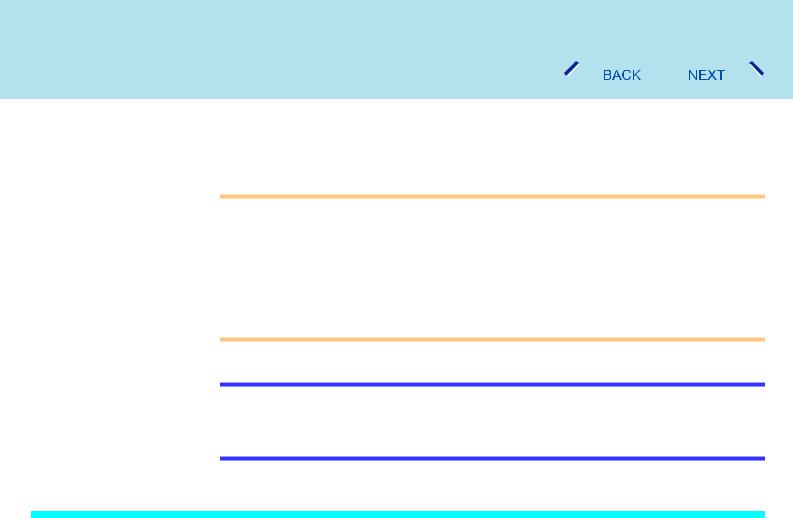
Touch Pad
15
*1 |
The movements will differ depending on the application. |
*2 |
Operations to follow when using an external Microsoft® IntelliMouse™. |
*3 |
Operation applicable to the Microsoft® IntelliMouse™ Wheel mode. |
CAUTION
<Models with touchscreen>
z Do not remove [touchpad/touchscreen] in the following menu.
[start] - [Control Panel] - [Performance and Maintenance] - [System] - [Hardware] - [Device Manager] - [Mice and other pointing devices]
<Models without touchscreen>
zDo not remove [touchpad] in the following menu.
[start] - [Control Panel] - [Performance and Maintenance] - [System] - [Hardware] - [Device Manager] - [Mice and other pointing devices]
NOTE
zThe double-tapping speed of the touch pad can be changed using the following menu. [start] - [Control Panel] - [Printers and Other Hardware] - [Mouse] - [Tap and Buttons] - [Double-click Speed]
zThe touch pad cannot be used in the Setup Utility.
When you want to use an external mouse through the external keyboard/mouse port
When an external mouse or trackball with additional functions (e.g., wheel function) is connected, a part or all of the additional functions may fail to operate. To use these additional functions, perform the operation below.
If you are using a USB mouse, the following operation is unnecessary.
1 Power off your computer ( Operating Instructions "Starting Up/ Shutting Down") and connect the external mouse or trackball to the computer.
2 Turn the power on and run the Setup Utility (Î page 82).

Touch Pad
16
3 In [Main] menu, set [Touch Pad] and [Touchscreen] (only for models with touchscreen) to [Disable].
4 Close the Setup Utility by pressing F10. At the confirmation message, select [Yes].
5 Log on to Windows with the administrator authority (only necessary when multiple accounts are created).
6 When the message [Completing the Found New Hardware Wizard] is displayed, select [Finish].
It may take a few minutes to complete this operation.
7 If the display asks you to restart Windows, select [Yes].
The computer will restart.
8 Following the operating instructions of the connected external mouse or trackball, install the necessary driver.
NOTE
z When you want to use the PS/2 compatible mouse:
ASelect [start] - [Control Panel] - [Performance and Maintenance] - [System] - [Hardware] - [Device Manager] - [Mice and other pointing devices].
BSelect [touchpad/touchscreen] (models with touchscreen) or [touchpad] (models without touchscreen), then select [Update Driver] at [Driver].
CSelect [Install from a list or specific location] and select [Next].
DSelect [Don't search. I will choose driver to install.], then select [Next].
ESelect [PS/2 Compatible Mouse], then select [Next].
FAt the confirmation message, select [Yes].
GSelect [Finish], then select [Close].
HThe display will ask you to restart Windows, select [Yes]. The computer will restart.

Touch Pad
17
When you want to re-enable the Touch Pad and touchscreen (only for models with touchscreen)
1 Uninstall the driver or application software of an external mouse or trackball. (Refer to the operating instructions of the external device on how to uninstall the driver.)
If the explanation of uninstalling the driver or application software can not be found in the operating instructions for the external device, execute the following steps.
AIn [start] - [Control Panel] - [Performance and Maintenance] - [System] -
[Hardware] - [Device Manager], when an external mouse or trackball device is displayed in [Mice and other pointing devices], press Del to delete it.
BIf the confirmation message is displayed, select [OK].
2
3
If the display asks you to restart Windows, select [No].
Power off your computer ( Operating Instructions "Starting Up/ Shutting Down") and remove the external mouse or trackball.
4
5
Turn the power on and run the Setup Utility (Î page 82).
In [Main] menu, set [Touch Pad] and [Touchscreen] (only for models with touchscreen) to [Enable].
6 Close the Setup Utility by pressing F10. At the confirmation message, select [Yes].
7 Log on to Windows with the administrator authority (only necessary when multiple accounts are created).
8 Select [start] - [Control Panel] - [Printers and Other Hardware] - [Mouse] - [Hardware].
9 Confirm that [touchpad/touchscreen](models with touchscreen) or [touchpad](models without touchscreen) is displayed at [Devices].
<When [touchpad/touchscreen](models with touchscreen) or [touchpad](models without touchscreen) is not displayed>

Touch Pad
18
ASelect the external mouse or trackball and then select [Properties].
BSelect [Driver] and then select [Update Driver].
CAt [Welcome to the Hardware Update Wizard], select [Install from a list or specific location] and then select [Next].
DSelect [Don't search. I will choose the driver to install.] and then select [Next].
ESelect [Have Disk], input [c:\util\drivers\mouse] at [Copy manufacturer's files from], then select [OK].
FSelect [touchpad/touchscreen] (models with touchscreen) or [touchpad] (models without touchscreen) and then select [Next].
If the some item names are displayed, select one.
If [xx has not passed Windows Logo testing....] is displayed, select [Continue Anyway].
GSelect [Finish] and then select [Close].
HThe display will ask you to restart Windows. Select [Yes]. The computer will restart.
<When [touchpad/touchscreen](models with touchscreen) or [touchpad](models without touchscreen) is displayed>
A Select [OK].
<Only for models with touchscreen>
10 Perform the touchscreen calibration.(Î page 21)
Handling the Touch Pad
zBy design the touch pad is to be used with a finger tip only. Do not place any object on the work surface or press down forcefully with sharp-pointed objects (e.g., nails) or hard objects that can leave marks (e.g., pencils and ball point pens).
zTry to avoid having any harmful substances such as oil, come in contact with the touch pad. The cursor may not work properly in such cases.
zWhen the touch pad becomes dirty:
Wipe to remove dirt by using a dry soft cloth such as gauze or a soft cloth first applied with detergent diluted with water and then thoroughly wrung.
Do not use benzene or thinner, or rubbing alcohol. Doing so may adversely affect the surface, e.g., discoloration. In addition, do not use commercially-available household cleaners and cosmetics, as they may contain components harmful to the surface.

Touchscreen
19
Only for models with touchscreen
Your computer is equipped with a touchscreen function allowing you to perform the same operations as the touch pad or mouse by touching the surface of the display with the stylus (included). If the cursor cannot be pointed correctly with the stylus, perform [Calibration]. ( page 21)
The following explanation gives one example (for the default settings).
The operation settings can be changed. ( |
page 21) |
|
|
Functions |
Operation |
Moving the cursor |
|
|
The cursor is moved to the location |
|
pointed by the stylus. |
Clicking (Tapping)
One tap
Double-clicking |
|
(Double-tapping) |
Two quick taps |
Dragging
Touch and hold the object (i.e. file or icon), move the stylus on the surface (dragging the object to the desired location), then release the stylus.
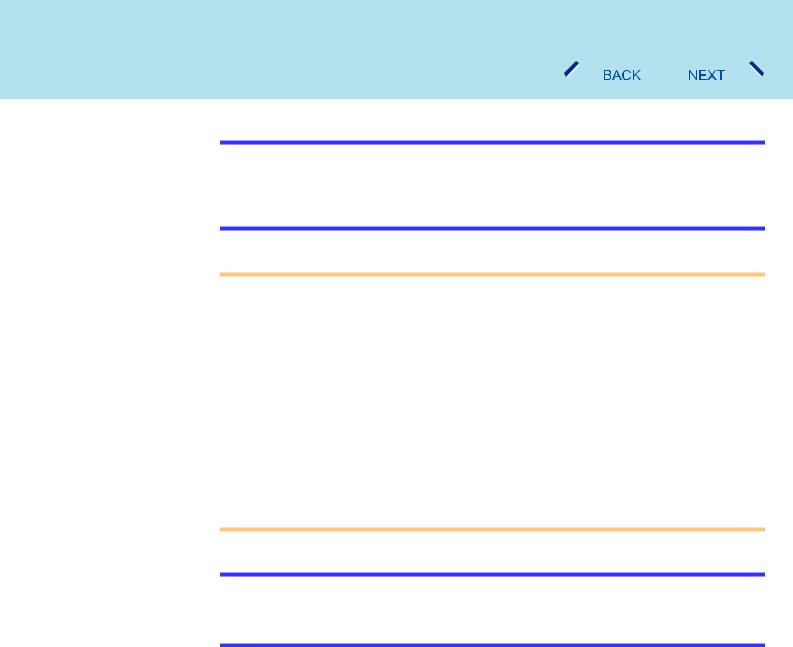
Touchscreen
20
NOTE
To right-click:
ASelect  on the taskbar.
on the taskbar.
 changes to
changes to  .
.
BSelect the object you want to right-click.
CAUTION
When the internal LCD is used alone or with an external display simultaneously, the touchscreen function will not work properly when the area of either display is set larger than default setting of the display resolution.
If a change is made to the display resolution, or the cursor can not be pointed correctly with the stylus, be sure to perform [Calibration]. ( page 21)
When mouse drivers are installed (e.g., Intellimouse), the touchscreen function may not be used.
When you want to uninstall or reinstall the touchscreen (touch pad) driver, refer to the "Touch Pad (Advanced)". ( page 15)
Even when only an external display is in use, the cursor will move on the external display if the surface of the internal LCD is touched when the touchscreen driver is active. Therefore, do not touch the internal LCD when only an external display is in use.
The touchscreen function can not be used when using the full screen in [Command Prompt].
NOTE
Select  on the desktop to view [Important Tips] for using the touchscreen. You can also view [Important Tips] using the following procedures.
on the desktop to view [Important Tips] for using the touchscreen. You can also view [Important Tips] using the following procedures.
Select [Important Tips] in [start] - [All Programs] - [Panasonic] - [On-Line Manuals].
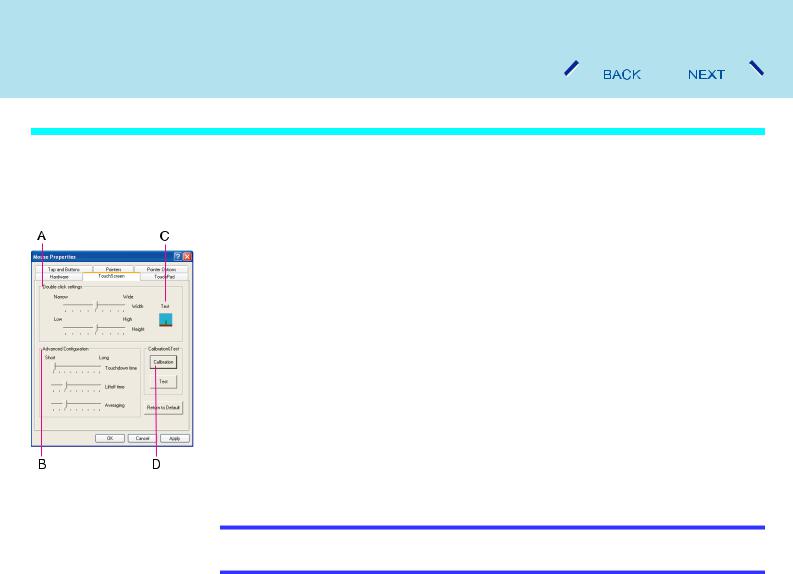
Touchscreen
21
Configuring the Touchscreen
When needed, the touchscreen can be configured using the following steps.
1 Display [Mouse Properties] screen.
Select  on the taskbar and then select [TouchScreen] or select [TouchScreen] in [start] - [Control Panel] - [Printers and Other Hardware] - [Mouse].
on the taskbar and then select [TouchScreen] or select [TouchScreen] in [start] - [Control Panel] - [Printers and Other Hardware] - [Mouse].
A. Double click settings
Set the width and height of the double click.
B.Advanced configuration Set the advanced settings.
C.Test
Test for the "Double click settings".
D.Calibration & Test
Define the calibration setup. Use this procedure when the cursor, the stylus (included) touches do not appear to agree. (Necessary for changes in the alignment of the touchscreen with visual images or an adjustment of the display resolution.)
Touch the "+" mark on the calibration screen for about one second.
After the calibration procedure is executed (e.g., after the nine "+" marks are touched), the procedure ends when Enter is pressed.
2 Make necessary changes and select [OK].
NOTE
The double-click speed of the touchscreen can be changed in [Tap and Buttons].
For more information, click  at the upper right corner.
at the upper right corner.

Touchscreen
22
Handling the Touchscreen
Use the stylus included with the computer. Do not use pencils, implements with sharp tips or hard objects for screen operations.
Do not place any object on the surface or press down forcefully with sharp-pointed objects (e.g., nails), or hard objects that can leave marks (e.g., pencils and ball point pens).
Do not operate the computer when such things as dust are on the screen. Do not allow contact with substances that could dirty the touchscreen, such as oil.
When the touchscreen becomes dirty:
•Wipe to remove dirt by using a dry soft cloth included with the computer.
•Do not use benzene or thinner, or rubbing alcohol.
•For more information, refer to "Suggestions About Cleaning the LCD Surface" that comes with the soft cloth.
Handling the Stylus
Clean the stylus tip and screen prior to operation. Foreign particles can scratch the screen and impede the operation of the stylus.
Use the stylus only for the computer screen. Using it for any other purpose may damage the stylus and scratch the screen.

Panasonic Hand Writing
23
Simple characters and figures like signatures and arrows can be made by using the work surface of the touch pad or the touchscreen (only for models with touchscreen), and can be saved to a file as a bitmap (.bmp) format.
Any change to the size of an image must be made before beginning to draw. If the image size is changed after the drawing is completed, the image (quality) will not be sharp. Data can be copied to the clipboard with [Edit] - [Copy]. Copied data can be added to other applications that support the bitmap format by using the paste function.
The file size of a bitmap image to be saved or pasted to another application can be changed with [Option] - [Window size].
Changing the number of colors of the display may affect the Panasonic Hand Writing screen. If the screen is affected, click  on the taskbar with the right mouse button, close the application by selecting [Exit Panasonic Hand Writing], and then run Panasonic Hand Writing again.
on the taskbar with the right mouse button, close the application by selecting [Exit Panasonic Hand Writing], and then run Panasonic Hand Writing again.
Drawing accuracy may be degraded if another application, such as disk accessing, is being executed simultaneously. Begin drawing only after other applications have been closed.
NOTE
If a commercially-available pointing device (e.g., mouse) driver is installed and overwrites the driver of the touch pad, Panasonic Hand Writing will no longer work.
Drawing Characters or Figures
CAUTION
Do not use the Fast User Switching function while Panasonic Hand Writing is in use.
1 Select  on the taskbar or run Panasonic Hand Writing as the following procedure.
on the taskbar or run Panasonic Hand Writing as the following procedure.
Select [Panasonic Hand Writing] from [start] - [All Programs] - [Panasonic].
2 Draw a character or figure.
When using the Touch Pad mode
Positions on the work surface of the touch pad have corresponding positions in the Panasonic Hand Writing window. For example, a character or figure made in the
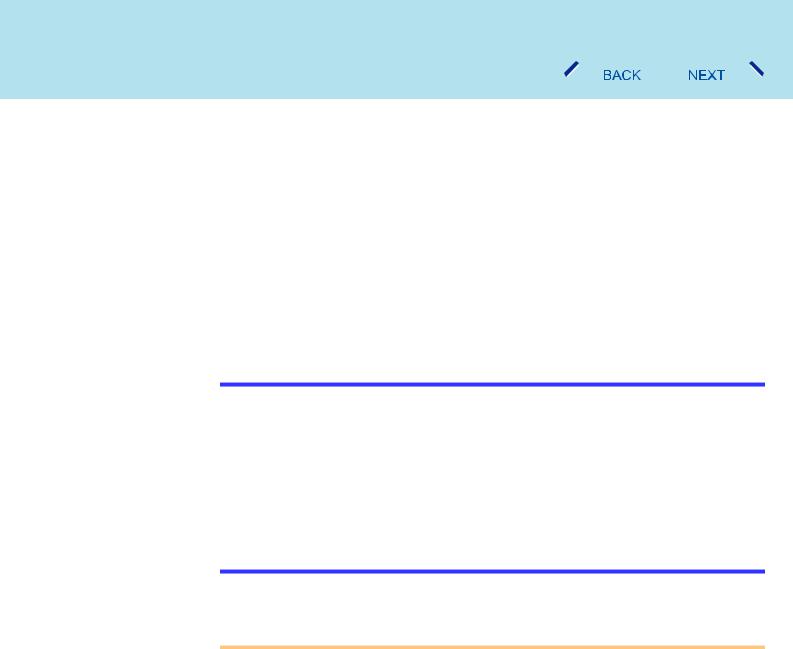
Panasonic Hand Writing
24
top-left part of the work surface of the touch pad will be displayed in the top left part of the Panasonic Hand Writing window.
ASelect  or select [Touch Pad mode] in [Option].
or select [Touch Pad mode] in [Option].
BDraw a character or figure using the touch pad.
Determine the position to begin drawing while pressing down on the right button of the touch pad. After determining this position, release your finger from the button and draw. (Drawing is not possible while the right button of the touch pad is being pressed.)
CPress the left button of the touch pad to end the Touch Pad mode. When not using the Touch Pad mode
ADrag*1 across the Panasonic Hand Writing window to draw a character or figure.
*1 touch pad: page 11
touchscreen (only for models with touchscreen): page 19
NOTE
Do not operate any of the followings when using the Panasonic Hand Writing in the
Touch Pad mode. The Touch Pad mode will be cancelled.
•Switch to another application.
•Resume operation from the standby or hibernation mode.
•Display the settings screen for [Panasonic Hand Writing].
•Select a menu after pressing Alt.
•Touch the touchscreen (only for models with touchscreen).
In the following case, the Touch Pad mode does not work properly.
• When the computer is in the Extended Desktop.
When a screen saver has been set, it may start up during input in the Touch Pad mode.
3 Select [Save As] or [Save] from [File].
CAUTION
In the Touch Pad mode, an external mouse or trackball connected to the external keyboard/mouse port will not operate.

Panasonic Hand Writing
25
<Only for models with touchscreen>
When using the touchscreen, use the stylus included with the computer. Do not use any of the following objects, as they may damage the work surface.
•Objects with an extremely sharp tip, like screwdrivers and nails.
•Objects that leave marks, like ball-point pens.
When using the touchscreen, do not perform a drag operation by the touch pad or the external mouse as the movement will be input on the display.
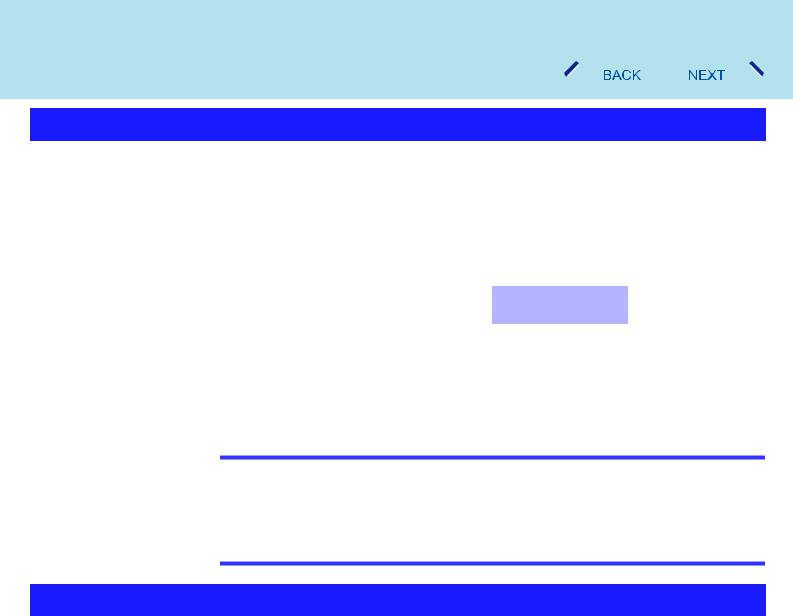
Standby/Hibernation Functions
26
Starting Up Your Computer Quickly
If you use the standby or hibernation function, you can shut down the computer without closing programs and documents. Upon restarting your computer from either the standby or hibernation mode, you can immediately continue working in all programs, or documents that were open at the time the computer was placed into standby or hibernation mode.
Differences between the Standby and Hibernation Functions
|
|
|
|
|
|
|
|
|
|
|
Function |
Where data is saved |
Time until recovery |
Requires power |
|
|
to |
|
supply |
|
Standby function |
Memory |
Short |
Yes |
|
|
|
|
(if power is cut, all |
|
|
|
|
data is lost) |
|
|
|
|
|
|
Hibernation function |
Hard disk |
Rather long |
Power is not required |
|
|
|
|
to maintain data |
|
|
|
|
|
NOTE
We recommend plugging in the AC adaptor if the standby function is to be used for a long period of time. If the AC adaptor cannot be connected, we recommend that hibernation mode be used instead of the standby mode.
If the standby or hibernation function is used repeatedly, the computer may not work properly. To stabilize computer operations, shut down Windows on a regular basis (about once a week) without using the standby or hibernation function.
Entering the Standby or Hibernation Mode
Use any of the following methods to enter the standby or hibernation mode. To use the hibernation mode, set [Power Options] in advance ( page 27). (Enabled in factory preset.)
Using Fn key combinations ( page 6) Using the power switch ( page 29) Using the display ( page 30)

Standby/Hibernation Functions
27
From the shutdown screen
•Standby
In [start] - [Turn Off Computer], select [Stand By].
•Hibernation
In [start] - [Turn Off Computer], press and hold Shift, then select [Hibernate].
Setting for Using the Hibernation Mode
At the time of purchase, the computer is set so that hibernation mode can be used.
1 Select [start] - [Control Panel] - [Performance and Maintenance] -
[Power Options].
2 In [Hibernate], add the check mark for [Enable hibernation] and select
[OK].
Precautions
Before entering the standby or hibernation mode
Be sure to save all data.
When a file in an external device such as a CD/DVD drive, external hard disk, or ATA card is opened, close the file.
Even when a password has been set in the Setup Utility, [Enter Password] does not appear when the computer resumes from the standby or hibernation mode. If you want to use the security function when using the standby or hibernation mode, use the Windows password as follows:
ASelect the account to change in [start] - [Control Panel] - [User Accounts].
BSet the password.
CAdd the check mark for [Prompt for password when computer resumes from standby] in [start] - [Control Panel] - [Performance and Maintenance] - [Power Options] - [Advanced].
Do not enter either the standby or hibernation mode under the following conditions. You may corrupt your data or file, the standby or hibernation function may not work, or the computer (or peripherals) may fail to work properly.

Standby/Hibernation Functions
28
•When the Multimedia pocket device indicator ( ) *1 or hard disk drive indicator (
) *1 or hard disk drive indicator ( ) is on.
) is on.
•When playing/recording audio files and displaying images (such as MPEG files).
•When playing a DVD-Video.
•When writing to a CD-R/RW disc.
•When using communications software or the network function.
•When using PC Cards.
(If these cards fail to work properly, restart the computer.)
•When an external mouse is connected to the serial port.
*1 Except when using a second battery pack
When entering the standby or hibernation mode
Standby mode: until the power indicator blinks green
Hibernation mode: until the power indicator goes off
Avoid the following:
•Using the keyboard, touch pad, touchscreen (only for models with touchscreen.), or power switch.
•Using external mouse or other peripheral devices.
•Connecting or disconnecting the AC adaptor.
•Closing or opening the display.
In standby or hibernation mode
Do not insert or remove peripherals; abnormal operation may result.
Do not insert or remove the Multimedia pocket device. (Except when using a second battery pack)
In standby mode, power is consumed. If PC Cards are inserted, more of that power is consumed. When all power has been consumed, all data saved at standby is lost since it is retained in memory. We therefore recommend plugging in the AC adaptor when using the standby function.
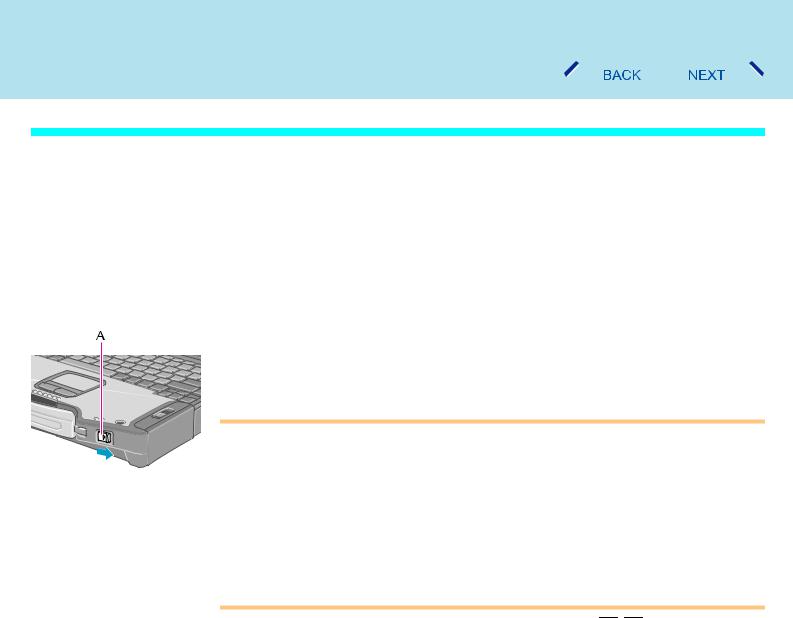
Standby/Hibernation Functions
29
Using the Power Switch
Setting
1 Select [start] - [Control Panel] - [Performance and Maintenance] -
[Power Options] - [Advanced].
2 Select [Stand by] or [Hibernate] for [When I press the power button on my computer], and then select [OK].
Entering the standby or hibernation mode
1 Slide the power switch (A); at the beep*2 sound, release your finger.
The computer will enter either the standby or hibernation mode, depending on the setting.
CAUTION
After releasing your finger from the power switch, do not touch the power switch until the power indicator goes off or blinks.
At the beep*2 sound, release your finger from the power switch. If you continue to slide the power switch and hold it for more than four seconds, the computer will emit a
second beep*2 then power off. Data not previously saved will be lost.
Even when [When I press the power button on my computer] is set to [Shut down] with [start] - [Control Panel] - [Performance and Maintenance] - [Power Options] - [Advanced], if you slide the power switch for more than four seconds and do not
release it, a second beep*2 will sound and the power will be turned off forcibly. Data not previously saved will be lost.
*2 When the speaker function is disabled, e.g., by the key combination Fn+F4, there will be no beep sound.
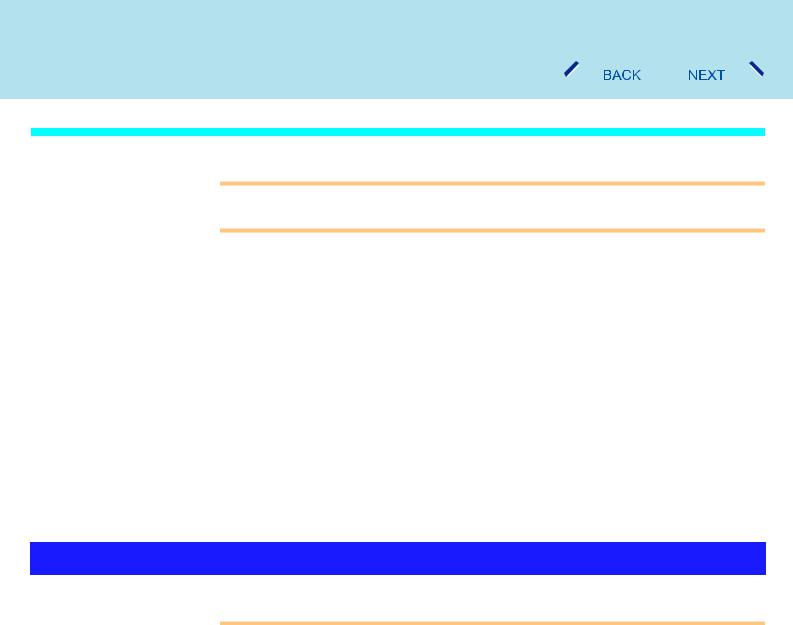
Standby/Hibernation Functions
30
Using the Display
CAUTION
Do not perform the following settings when the multimedia pocket device needs to be installed or removed.
Setting
1 Select [start] - [Control Panel] - [Performance and Maintenance] -
[Power Options] - [Advanced].
2 Select [Stand by] or [Hibernate] for [When I close the lid of my portable computer], and then select [OK].
Entering the standby or hibernation mode
1 Close the display.
The computer will enter either the standby or hibernation mode, depending on the setting.
When entering the standby or hibernation mode, close the display correctly. If you do not do so, (for example, if you open the display soon after you close it) the computer may not enter standby or hibernation mode.
Resuming Operation
CAUTION
Until resuming is complete (requires about 15 seconds, or 60 seconds if connected to a network, after the display returns), avoid the following:
•Touching the keyboard (except for password input), touch pad, touchscreen(only for models with touchscreen, or power switch.
•Using external mouse or other peripheral devices.
•Connecting or disconnecting the AC adaptor.
